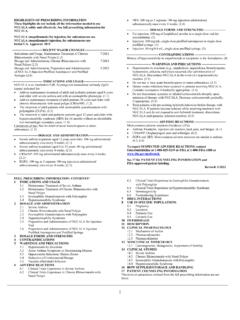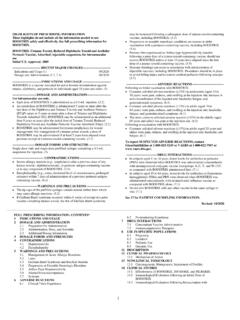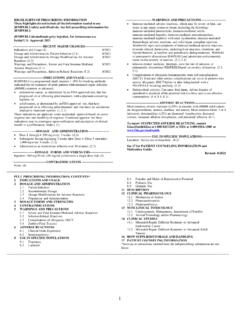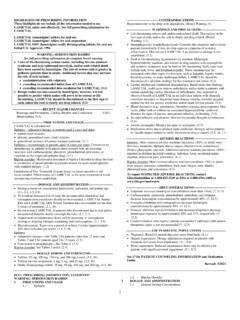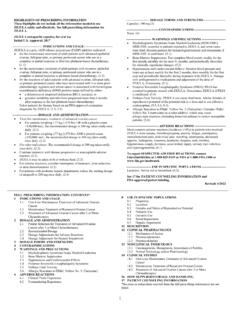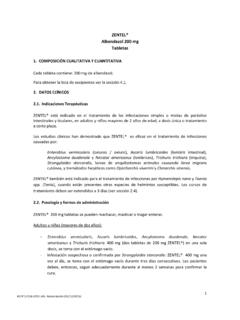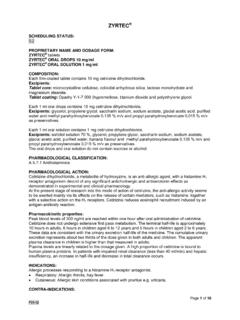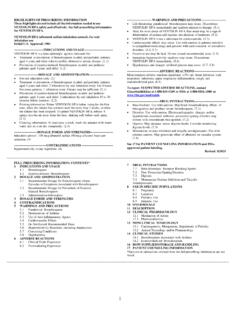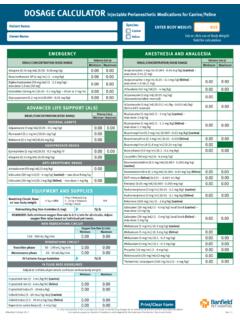Transcription of FULL PRESCRIBING INFORMATION 1 INDICATIONS AND USAGE
1 1 HIGHLIGHTS OF PRESCRIBING INFORMATION These highlights do not include all the INFORMATION needed to use FLOLAN safely and effectively. See full PRESCRIBING INFORMATION for FLOLAN. FLOLAN (epoprostenol sodium) for injection, for intravenous use Initial Approval: 1995 --------------------------- INDICATIONS AND USAGE ---------------------------- FLOLAN is a prostacyclin vasodilator indicated for the treatment of pulmonary arterial hypertension (PAH) (WHO Group I) to improve exercise capacity. Studies establishing effectiveness included predominantly (97%) patients with NYHA Functional Class III-IV symptoms and etiologies of idiopathic or heritable PAH (49 %) or PAH associated with connective tissue diseases (51 %).
2 (1) ----------------------- dosage AND ADMINISTRATION ----------------------- Initiate intravenous infusion through a central venous catheter at 2 ng/kg/min. ( , ) Change dose in 1- to 2-ng/kg/min increments at intervals of at least 15 minutes based on clinical response. ( ) Avoid sudden large dose reductions. (2. 2, 5. 2) --------------------- dosage FORMS AND STRENGTHS ---------------------- For injection: mg or mg of epoprostenol freeze-dried powder in a single-dose vial for reconstitution with the supplied diluent. (3) ------------------------------ CONTRAINDICATIONS ------------------------------ Heart failure with reduced ejection fraction.
3 (4) Hypersensitivity to FLOLAN or any of its ingredients. (4) ----------------------- WARNINGS AND PRECAUTIONS ----------------------- Pulmonary edema: Discontinue therapy if pulmonary edema occurs. ( ) Rebound pulmonary hypertension: Do not abruptly discontinue or decrease the dose. ( ) Vasodilation reactions: Monitor blood pressure and symptoms regularly during initiation and after dose change. ( ) Increased risk for bleeding: Increased risk for hemorrhagic complications, particularly for patients with other risk factors for bleeding. ( ) ------------------------------ ADVERSE REACTIONS ------------------------------ The most common adverse reactions are dizziness, jaw pain, headache, musculoskeletal pain, and nausea/vomiting, and are generally associated with vasodilation.
4 (6) To report SUSPECTED ADVERSE REACTIONS, contact GlaxoSmithKline at 1-888-825-5249 or FDA at 1-800-FDA-1088 or See 17 for PATIENT COUNSELING INFORMATION and FDA-approved patient labeling. Revised: 10 /2023 FULL PRESCRIBING INFORMATION : CONTENTS* 1 INDICATIONS AND USAGE 2 dosage AND ADMINISTRATION Reconstitution dosage Administration 3 dosage FORMS AND STRENGTHS 4 CONTRAINDICATIONS 5 WARNINGS AND PRECAUTIONS Pulmonary Edema Rebound Pulmonary Hypertension following Abrupt Withdrawal Vasodilation Increased Risk for Bleeding 6 ADVERSE REACTIONS Clinical Trials Experience Postmarketing Experience 8 USE IN SPECIFIC POPULATIONS Pregnancy Lactation Pediatric Use Geriatric Use 10 OVERDOSAGE 11 DESCRIPTION 12 CLINICAL PHARMACOLOGY Mechanism of Action Pharmacodynamics Pharmacokinetics 13 NONCLINICAL TOXICOLOGY Carcinogenesis, Mutagenesis.
5 Impairment of Fertility 14 CLINICAL STUDIES Chronic Infusion in Idiopathic or Heritable PAH Chronic Infusion in PAH/SSD Increased Mortality in Patients with Heart Failure Caused by Severe Left Ventricular Systolic Dysfunction 16 HOW SUPPLIED/STORAGE AND HANDLING How Supplied Storage and Handling 17 PATIENT COUNSELING INFORMATION *Sections or subsections omitted from the full PRESCRIBING INFORMATION are not listed. FULL PRESCRIBING INFORMATION 1 INDICATIONS AND USAGE FLOLAN is indicated for the treatment of pulmonary arterial hypertension (PAH) (WHO Group I) to improve exercise capacity. Trials establishing effectiveness included predominantly (97%) patients with New York Heart Association (NYHA) Functional Class III-IV symptoms and etiologies of idiopathic or heritable PAH (49%) or PAH associated with connective tissue diseases ( 51%).
6 2 dosage AND ADMINISTRATION Reconstitution Each vial is for single use only; discard any unused diluent or unused reconstituted solution. 2 Select a concentration for the solution of FLOLAN that is compatible with the infusion pump being used with respect to minimum and maximum flow rates, reservoir capacity, and the infusion pump criteria listed below [see dosage and Administration ( )]. Using aseptic technique, reconstitute FLOLAN only with pH 12 STERILE DILUENT for FLOLAN. Table 1 gives directions for preparing several different concentrations of FLOLAN. See storage and administration time limits for the reconstituted FLOLAN below. Table 1. Reconstitution and Dilution Instructions for FLOLAN Using pH 12 STERILE DILUENT for FLOLAN.
7 To make 100 mL of solution with final concentration of: Directions: 3,000 ng/mL Dissolve contents of one vial with 5 mL of sterile diluent. Withdraw 3 mL and add to sufficient sterile diluent to make a total of 100 mL. 5,000 ng/mL Dissolve contents of one vial with 5 mL of sterile diluent. Withdraw entire vial contents and add sufficient sterile diluent to make a total of 100 mL. 10,000 ng/mL Dissolve contents of two vials each with 5 mL of sterile diluent. Withdraw entire vial contents and add sufficient sterile diluent to make a total of 100 mL. 15,000 ng/mLa Dissolve contents of one vial with 5 mL of sterile diluent. Withdraw entire vial contents and add sufficient sterile diluent to make a total of 100 mL.
8 A Higher concentrations may be prepared for patients who receive FLOLAN long-term. Storage and Administration Limits for Reconstituted FLOLAN Freshly prepared reconstituted solutions or reconstituted solutions that have been stored at 2 C to 8 C (36 F to 46 F) for no longer than 8 days can be administered up to: o 48 hours at up to 25 C (77 F). o 36 hours at up to 30 C (86 F). o 24 hours at up to 35 C (95 F). o 12 hours at up to 40 C (104 F). Discard any unused solution after these times. Reconstituted solutions can be used immediately. Refrigerate at 2 C to 8 C (36 F to 46 F) if not used immediately. Protect from light. 3 Do not freeze reconstituted solutions.
9 dosage Initiate intravenous infusions of FLOLAN at 2 ng/kg/min. Alter the infusion by 1- to 2- ng/kg/min increments at intervals sufficient to allow assessment of clinical response. These intervals should be at least 15 minutes. During dose initiation, asymptomatic increases in pulmonary artery pressure coincident with increases in cardiac output may occur. In such cases, consider dose reduction, but such an increase does not imply that chronic treatment is contraindicated. Base changes in the chronic infusion rate on persistence, recurrence, or worsening of the patient's symptoms of pulmonary hypertension and the occurrence of adverse vasodilatory reactions.
10 In general, expect progressive increases in dose. If dose-related adverse reactions occur, make dose decreases gradually in 2-ng/kg/min decrements every 15 minutes or longer until the dose-limiting effects resolve [see Adverse Reactions ( , )]. Avoid abrupt withdrawal of FLOLAN or sudden large reductions in infusion rates [see Warnings and Precautions ( )]. Following establishment of a new chronic infusion rate, measure standing and supine blood pressure for several hours. Taper doses of FLOLAN after initiation of cardiopulmonary bypass in patients receiving lung transplants. Administration Initiate FLOLAN in a setting with adequate personnel and equipment for physiologic monitoring and emergency care.
